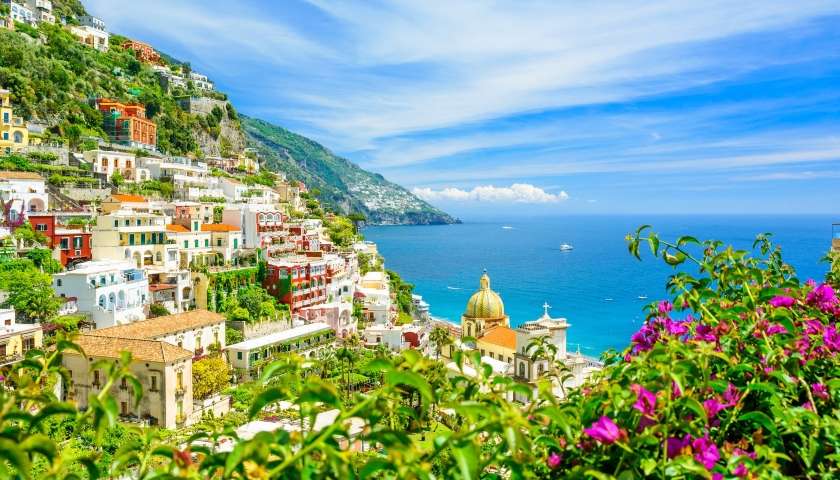Italy can pack a lot of beauty into very small spaces, as you’ll see when you arrive on the Amalfi Coast. The towns along this stretch of coastline rise precariously from the water. Buildings seem to grow from the rocky cliffs, and the roads that serve the area look as if they’re barely clinging to the land. This may be an unlikely place to build, but the Amalfi Coast - and the nearby islands in the Gulf of Naples - have been luring people for extended stays since the days of the Roman Empire.
Amalfi Coast Local History
Roman aristocracy built villas on the valley at the coast during the 1st Century AD and it was here, that centres of humanity were created. Thanks to the sailors, the Amalfi Coast was well known and its name appeared in an official letter from the Pope in 596 when trade was mentioned. It was also the only place that the Arabs could trade exports
Some research has found a wall structure on the seaside of Amalfi which is now underwater and was part of the old docking system in Amalfi from the 12th Century. With the collapse of the Roman Empire, the freed slaves built the first village around here and slowly these villages grew until today, where the Amalfi Coast has a mixture of history and natural beauty to attract the visitor.
Amalfi Coast Highlights
The Amalfi Coast covers more than 40 miles on the Sorrentine Peninsula, from about Positano to Vietri sul Mare. There are luxury hotels and budget accommodation options, and all of them are booked solid during the high summer season when visitors come from all over the world to sun themselves on the region’s beaches. In between sunbathing sessions, you can shop in the boutiques, sample the local limoncello and seafood, explore the Roman ruins on the island of Capri, and hike the Path of the Gods.
Be prepared to fall in love with the amazing views - and to do a fair amount of up and down walking from hillside hotel rooms to beaches. The Amalfi Coast, as you’ll soon find out, is worth the effort.
Why Go to the Amalfi Coast?
- The hair-raising, white-knuckles, vertigo-inducing and totally incredible Amalfi drive.
- Amazing cliffside hotels where everyone from Greta Garbo to Angelina Jolie has sojourned.
- Boating to jewel-like coves and the Grotta dello Smeraldo (Emerald Grotto).
- Indulge yourself with some of Italy's finest cuisine
- Sample local limoncello
What To Skip: August, when every table, room, and mooring along the Amalfi Coast is full
What For: Beach, Food, Luxury, Romantic, Family
When to Go: Summer is the season to come here, of course—not only for the weather, but because most hotels and restaurants are seasonal. However, this is one of the country's most popular coastal destinations and can become very busy during the height of summer. It's best to avoid July and August and travel either side for great weather and fewer crowds.
Related Destinations: Capri
Is it worthwhile taking a trip to Capri from Amalfi?
Yes! Capri is an enchanting island that is easily accessible by ferry from Amalfi. While it is famous for the mesmerizing Blue Grotto, the island itself is breathtaking with its splendid natural beauty and colorful landscapes set in the deep blue Mediterranean Sea.
Upon arrival by ferry, you will ascend to the town of Capri via funicular. Visit the boutiques for exquisite Italian linens and laces, and then pause for a moment for a meal at one of the many local cafes for mouthwatering cuisine. Pack your bathing suit and relax on one of the many gorgeous beaches that dot the coast. To reach Capri, take one of the frequent ferries or hydrofoils from the town of Amalfi or Positano.
Insider Tip: Check the timetable of the ferry at the terminal as times can change. Buy your tickets in advance to avoid long lines at the docks.
Can I get from the Amalfi Coast to Pompeii for a day trip?
Yes! You can reach Pompeii by taking the SITA public bus to Sorrento. From Sorrento, take the Circumvesuviana (regional train) to Pompei. The train station in Pompeii is about 50 meters from the entrance to the ruins. As a UNESCO-designated world heritage site dating back to AD 79, when Mt. Vesuvius erupted and a layer of hot pumice stone covered the entire town, Pompeii is definitely worth visiting while you are vacationing on the Amalfi coast.
It is one of Europe's top archaeological sites and serves as a reminder of what the forces of nature are capable of. An express train can get you from Sorrento to Pompeii in as little as 30 minutes.
Insider Tip: Try to get to Pompeii early, so you avoid the throngs of visitors and the heat of the midday sun.
How to get to the Amalfi Coast
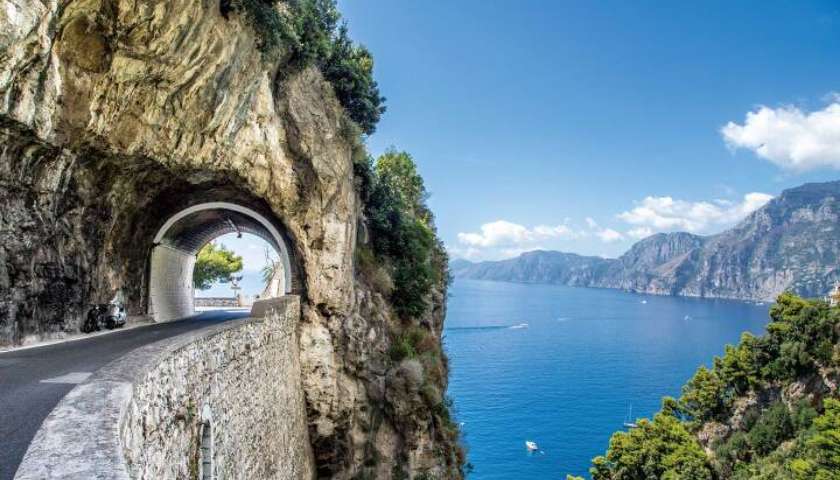 By air
By air
The closest airport is Naples Capodichino International Airport (NAP), about 40 miles northwest of Amalfi.
By train
You can travel from Rome to Naples and then take the scenic Circumvesuviana to Sorrento.
By boat
A hydrofoil service connects Naples with Sorrento.
By rental car
You can also drive along the coast but be prepared for a narrow, windy road that's often crowded.
By private driver
You can hire a driver to take you to your destination.
Moving around
Transportation along the Amalfi Coast is easier in the summer because you have more options. You can get around by bus, car, or motor scooter - just as you can year-round - but in the summer you can also get from town to town by boat. In the off-season (and in inclement weather) the boats don’t run due to rougher waters, but in the summer you can take boats to hop along the Amalfi Coast, or to get from the Amalfi Coast to Naples or the islands just off the coast.
Where to stay on the Amalfi Coast
Some of Italy's most renowned luxury hotels cluster in or near Amalfi, Positano, and Ravello. Though groups such as Belmond and SLH now have their own flagship properties on the Amalfi Coast, several of the leading hotels are still family-owned and family-run—evidence of the small-scale, personal approach that, luckily, still prevails in this international jet-set destination.
One thing you don't come to the Amalfi Coast for is value for money, though if you're prepared to risk the weather at the beginning (April–May) and end (October) of the season, there are reductions to be had. And there are one or two budget options that are a cut above the usual drab pensione standard.
Where to eat on the Amalfi Coast
On the Amalfi Coast, unsurprisingly, seafood dominates most menus: Spaghetti alle vongole, mussels, squid, octopus, and countless native fish. Local wine producers have made progress in leaps and bounds in recent years; look out for wines made from the white Fiano di Avellino or red Aglianico grapes. Note that some of the best dining on the Amalfi Coast is to be found just outside the main tourist area—west in the unassuming family resort of Marina di Cantone, and east in the working fishing port of Cetara.
Visiting the Amalfi Coast in Summer
The Amalfi Coast is a popular tourist draw at almost any time of year, but at no time is it more of a magnet for visitors than in the summer months when beaches are full to capacity with sun worshipers and luxury hotels host honeymooners and celebrities alike. Visiting the Amalfi Coast in the summer may be on your to-do list, but since countless other people are planning to be there at the same time, you’ll want to do a little research beforehand.
Summer on the Amalfi Coast is technically June-August, although the high season with its corresponding hot weather, big crowds, and high prices usually runs from May through September. The hot weather is ideal for the top tourist pursuit on the coast - lounging on the beach - so soaring temperatures aren’t a deterrent for visitors. In fact, the weather is part of what attracts people by the thousands each summer.
The crowds on the Amalfi Coast in the summer are responsible for hotel rooms being booked up months in advance, as well as for beaches being crowded nearly all day long. Even the many private beaches and beach clubs that require an admission fee are packed during the summer. To get a spot on the sand or an already-set-up beach chair and umbrella, you’ll need to stake your claim early in the day or head to one of the more remote beaches rather than the ones right in the town centers. Also keep in mind that larger crowds mean tours to nearby sights like Pompeii, Naples, Capri, and Mt. Vesuvius are also likely to sell out well in advance.
High season means high prices on the Amalfi Coast, which isn’t exactly cheap even in the off-season. There are accommodation options in different price ranges along the coast, including luxury hotels and apartment rentals, but all prices go up in the summer. As mentioned, accommodation for the summer tends to also be booked much further in advance, too, as people plan their high season holidays. So if you’re on a tighter budget and you’re going to the Amalfi Coast in the summer, research and book your lodging as soon as you can.
Visiting the Amalfi Coast in Winter
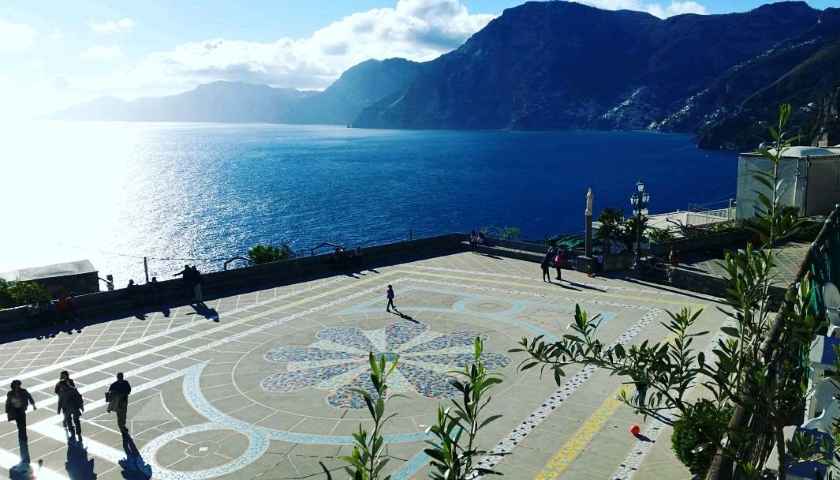 We don't want to discourage you but unfortunately winter is not the best season to visit the Amalfi Coast. The off-season can particularly affect the coastal towns on the Amalfi Coast, which are primarily summer destinations. Many coastal properties, restaurants and shops close for the winter. It’s also important to keep in mind that the winter months on Amalfi Coast can be stormy and that there isn’t a lot to do indoors when the weather is inclement.
We don't want to discourage you but unfortunately winter is not the best season to visit the Amalfi Coast. The off-season can particularly affect the coastal towns on the Amalfi Coast, which are primarily summer destinations. Many coastal properties, restaurants and shops close for the winter. It’s also important to keep in mind that the winter months on Amalfi Coast can be stormy and that there isn’t a lot to do indoors when the weather is inclement.
Visiting the Amalfi Coast with Kids in Tow
 The charming Amalfi Coast is a fantastic destination in Italy for a family trip with the kids. Blessed with a beautiful coastline, clear waters and hillsides dotted with picturesque towns, the Amalfi Coast is the perfect beach vacation destination for a holiday with the kids and it is also great for culturally curious families.
The charming Amalfi Coast is a fantastic destination in Italy for a family trip with the kids. Blessed with a beautiful coastline, clear waters and hillsides dotted with picturesque towns, the Amalfi Coast is the perfect beach vacation destination for a holiday with the kids and it is also great for culturally curious families.
Amalfi Coast Private Tours
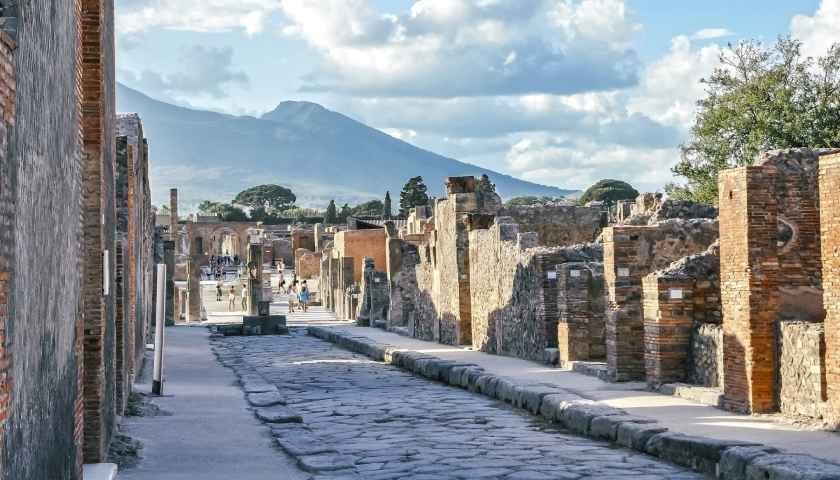
The scenic Amalfi Coast is one of southern Italy's top destinations. A good way to experience this picturesque area is on a tour. Here are some private tours on the Amalfi Coast we suggest. These private tours are also available from Naples so if you're arriving on a cruise ship, you could consider these for port excursions.
Amalfi Coast Private Chauffeured Day Tour
Driving along the famous Amalfi Coast can be a stressful experience so it's nice to explore with your own local driver to chauffeur you from town to town. The villages scattered along the sublime coast road have always attracted visitors, bewitching all who visit. The charm lies not only in the towns themselves but also in their history and rich legacy of fine churches, villas and monasteries. By taking a private tour, you have the option to spend as little or as much time as possible in the picturesque spots of your choosing. This luxurious private chauffeured tour departs and returns to any location on the Amalfi Coast including Sorrento and Naples.
Pompeii & Herculaneum Private Tour
Visit the UNESCO-listed sites of Pompeii and Herculaneum, both destroyed by the infamous eruption of Mt Vesuvius in 79 AD. Your private driver will pick you up and return you to any location on the Amalfi Coast or Naples. Hear about the infamous eruption of Mt Vesuvius and witness its destruction first hand as you explore the ruins by foot with an expert guide. The private tour includes transportation in an air-conditioned luxury sedan or minivan, licensed professional local guide and admission to the excavation sites.
Pompeii Private Guided Walking Tour
If you are arriving into Pompeii on your own, a licensed professional local guide will meet you directly at the site. Walk down the original Roman streets past ancient shops and houses, and admire some of the still-vivid frescoes and mosaics that attest to the wealth of some of Pompeii’s elite. Explore the Forum, once Pompeii’s bustling main square, and check out the fresco-adorned thermal baths as well as other sights, all as your guide recounts what life was like here 2,000 years ago.
The Amalfi Coast and its towns
The Amalfi Coast turns vertical living into an art form. Hotels burrow into the rock and send guests down to the beach by elevator; while in Positano, the sheer hillside is terraced not with vines but with white-and-pastel houses, each one seemingly rooted in its neighbor's roof. The rugged setting is softened by splashes of greenery. Lemon trees stride up the hillside in a series of giant steps, and every handkerchief-sized plot of flat land has been turned into a garden, an orchard, or a vegetable patch.
A single, narrow road winds precariously along the 25 miles of rocky coastline with the occasional hairpin variant branching off to traverse the saw-toothed ridge of the Monti Lattari, which separates the coast from Sorrento and the Bay of Naples to the north. Amalfi town is the area's big cultural draw, but the breathtaking coastline itself is the real reason for coming here.
Amalfi
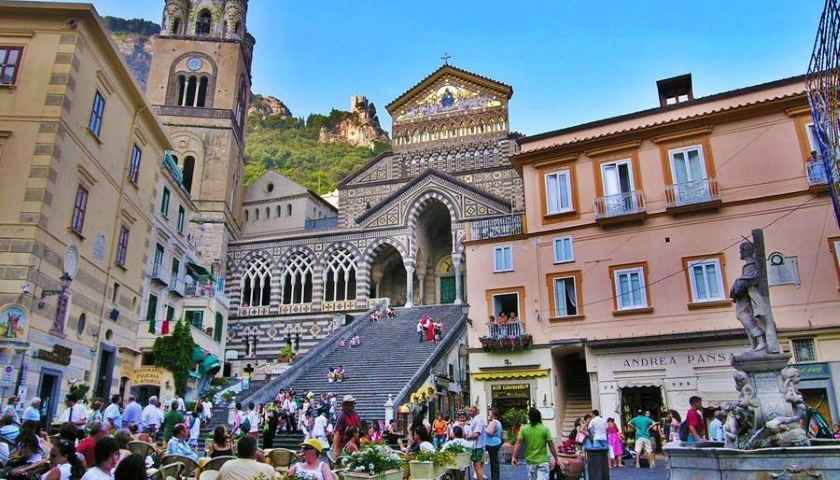 Amalfi, the town that gives the coastline its name, lies about halfway between Sorrento and Salerno. Its name is derived from that of the nymph, Amalfi, loved by Hercules—legend has it that he buried her in the world's most beautiful spot after she died. Though it's entirely given up to tourism today, this was once a proud maritime republic, founded in the ninth century, which rivaled Genoa, Pisa, and Venice in stature and power.
Amalfi, the town that gives the coastline its name, lies about halfway between Sorrento and Salerno. Its name is derived from that of the nymph, Amalfi, loved by Hercules—legend has it that he buried her in the world's most beautiful spot after she died. Though it's entirely given up to tourism today, this was once a proud maritime republic, founded in the ninth century, which rivaled Genoa, Pisa, and Venice in stature and power.
The bustling, café-lined port is served by hydrofoils to and from Salerno, Positano, and Capri, while the bus terminus on the quay offers road connections to Salerno, Ravello, Positano, and Sorrento. Buses to the latter two towns also pass by the upper entrance to the Grotta dello Smeraldo, a famous cave with 33-foot deep, crystal-clear waters that shimmer with emerald-green light thanks to an underground crevice.
From the harbor area, pass under the Porta Marinara gate into Piazza del Duomo, pictured, Amalfi's open-air living room, which is dominated by the magnificent Duomo di Sant'Andrea. It's well worth scaling the steps to see the cathedral's splendid bronze door, cast in Constantinople in the 11th century, and its 13th-century Romanesque-Arabian cloisters, the aptly named Chiostro del Paradiso. You should also try to get away from the touristy main street into the narrow pedestrian streets above, which offer a glimpse of the town's unusual, Moorish-influenced vernacular architecture with its whitewashed houses linked by arches and vaults—some of them so long that they turn certain lanes into tunnels.
Amalfi Drive
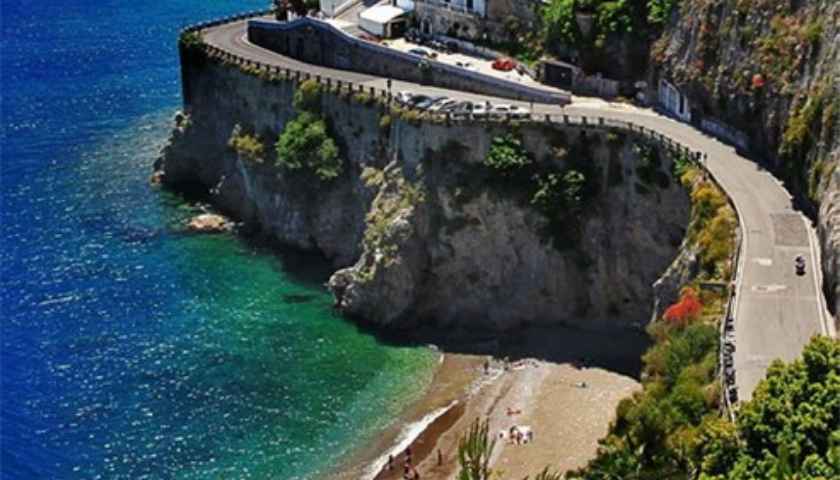 The corniche road, Amalfi drive, provides one of the world's hairiest and most scenic driving experiences providing vista after stunning vista of gorges, bridges and villages tucked picturesquely into the landscape. Of course, the designated driver will miss the scenery, being too busy concentrating on the white knuckles: John Steinbeck, who used to come here in the 1950s, claimed the Amalfi Drive was "carefully designed to be a little narrower than two cars side by side."
The corniche road, Amalfi drive, provides one of the world's hairiest and most scenic driving experiences providing vista after stunning vista of gorges, bridges and villages tucked picturesquely into the landscape. Of course, the designated driver will miss the scenery, being too busy concentrating on the white knuckles: John Steinbeck, who used to come here in the 1950s, claimed the Amalfi Drive was "carefully designed to be a little narrower than two cars side by side."
From the east, the route begins in Salerno, a working port city with a Norman Duomo. Beyond the town of Vietri sul Mare, famous for its colorful ceramicware, the road skirts the imposing bulk of Monte dell'Avvocata, passing Cetara, a salty fishing town that represents the Amalfi Coast at its least touristy. After the low-key resorts of Maiori and Minori comes the historic town of Amalfi, the coast's unofficial capital. Worthwhile stops between Amalfi and Positano include the Vallone di Furore, pictured, a rare Mediterranean fjord, whose steep rock walls shelter an enclave of fishermen's houses and their tiny harbor and Praiano, a pretty, low-key alternative to the glitz of Positano.
West of Positano, the road enters its most spectacular stretch: the nine-mile Nastro Azzurro, which clings to the side of the cliffs as it climbs to Sant'Agata sui Due Golfi. From there, it's a steep descent down into Sorrento on the other side of the peninsula.
The best hotels in Amalfi
5-star Hotel Santa Caterina
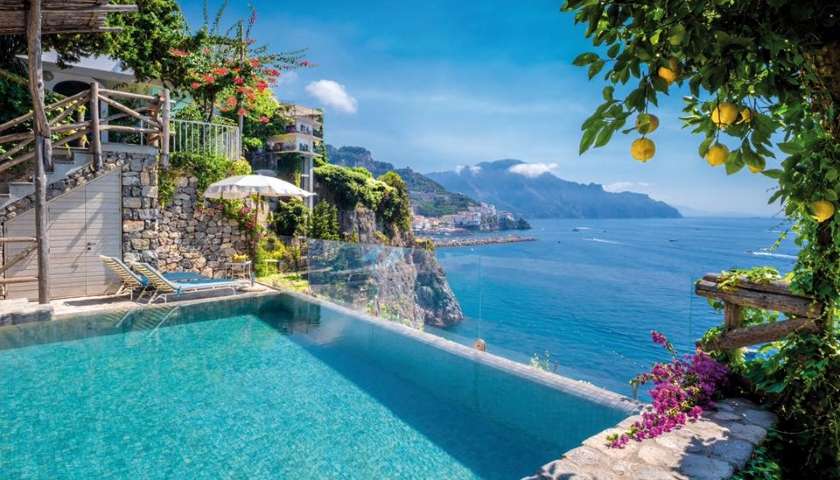
Built in 1904, the oldest of the Amalfi Coast's grand hotels, just outside town on the coast road, has been run by the same family for four generations. Such continuity pays off in serenity and in service that runs like clockwork. There is also a certain lived-in feel to this gracious 53-room mansion, which Brad Pitt and Angelina Jolie enjoyed during the filming of Mr. & Mrs. Smith.
Rooms in the main building feature patterned Vietri or white-tiled floors, early 19th-century antiques, and balconies looking over the sea toward Amalfi's yacht harbor. Thirteen other separate accommodations are set among the verdant grounds, including four "garden suites." (The most spectacular is the Chalet Giulietta e Romeo, a little honeymoon cottage perched at the edge of the cliff amid the orange groves.) Two rock-cut elevators lead down through the cliff to the rocky bathing area and saltwater pool below. There's also a spa and two restaurants: the high-up and fancy Michelin Star Glicine and the beachy and casual Al Mare with a wood-fired pizza oven. Book your stay.
3-star Residenza del Duca Rooms & Apartments
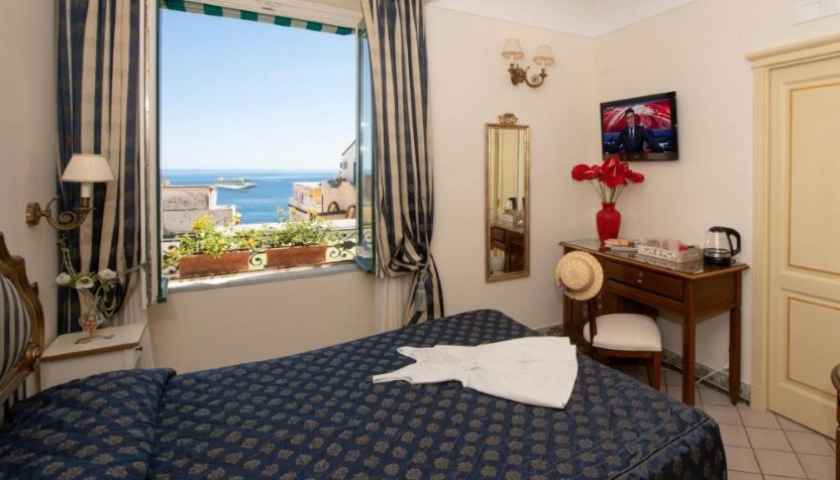
If you can deal with this compact charmer's downside—74 steps up from the street and no elevator (although happily there's a porter service at the bottom of the stairs)—you'll discover what is currently the best budget option in Amalfi. The building that hosts the hotel was once a palace owned by one of this mercantile town's aristocratic families. The upper floor, where the Residenza is located, dates back to the 16th century and still conserves its original chestnut roof beams.
Each room is done up in a subtly different color scheme with rich fabrics, stenciled or gilded headboards and a sapient sprinkling of antique furniture. There's AC throughout, and all the showers in the pretty bathrooms—tiled with reproductions of historical Vietri patterns—have massage jets. That the hotel is open year-round, a rarity on the Amalfi Coast, is another plus. Book your stay.
3-star Villa Lara
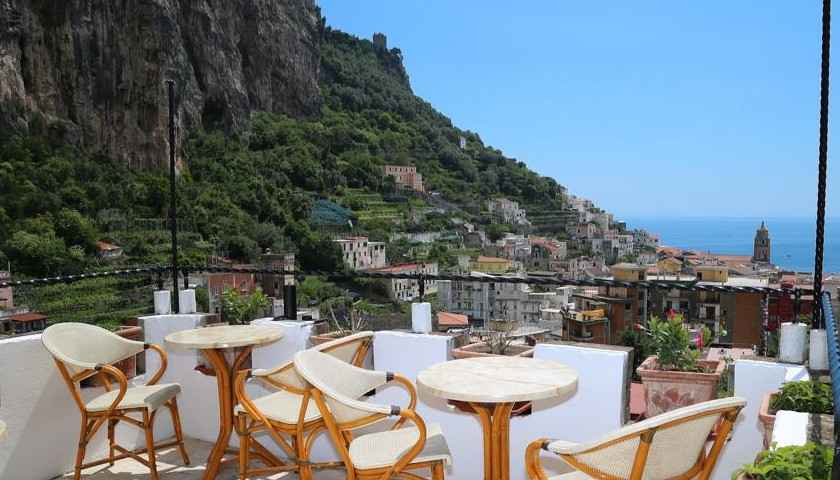
The best budget option in town, this six-room hotel is perched well above the tourist hordes, among the terraced vineyards and orchards that rise above the inland stretch of Via delle Cartiere, Amalfi's main street. From the gate down below, a short path leads past orange gardens and through a short tunnel to the elevator, which carries guests up to the white, 19th-century villa in exactly 50 seconds.
Most of the spacious, white-walled, air-conditioned rooms have views across terraced vineyards, a tumble of rooftops, and majolica church domes to the sea, though a couple of the upper rooms are under the eaves and illuminated only by skylights. The decor is typical Amalfi-seaside, with colorful Vietri-tiled floors and baths, beamed ceilings, and king-size beds. Breakfast is served on a pretty terrace overlooking the water. But it's the warm welcome and helpfulness of the staff (not always a given on the Amalfi Coast) that give Villa Lara an edge over competitors in this price range. Co-owner Nello Rispoli will happily steer you to the best local restaurants, walks, and beaches. Book your stay.
The best restaurants in Amalfi
La Caravella

La Caravella di Amalfi is one of the oldest starred restaurants in Italy. Located in the 12th century ducal palace of the Piccolomini family, this is a "museum restaurant" with twelve tables in the heart of Amalfi. Michelin star since the 1960s, La Caravella offers a classic fine dining, under the guidance of the Dipino family: "risotto with Amalfi lemon and raw prawns", "lemon caviar and mullet bottarga", and of "Pastina with lobster". You can spend up to 240 euros for the 10 course 60th anniversary menu, or 60 if you go for lunch. Looking for gluten free options? There's a eight-course tasting menu at euro 180 per person. Open Wednesdays through Mondays January through October.
Eolo
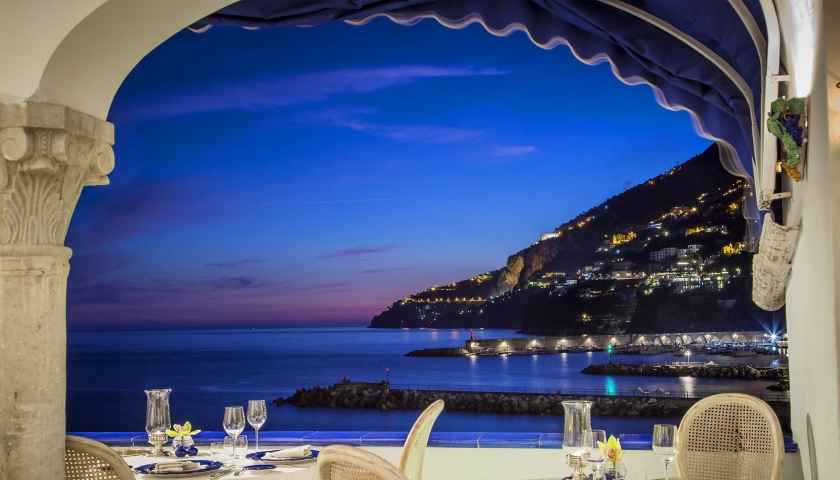
The granddaughter of Hotel Santa Caterina's founder runs this upscale, upstairs place with tasty views over Amalfi's harbor—at their best if you book one of the three coveted tables on the outside loggia. Expect sophisticated, evolved Neapolitan dishes, often decorated with seasonal flowers. The emphasis, unsurprisingly, is on seafood: cod-filled ravioli topped with a sauce based on tartufi di mare, a large local clam; sea bass with lemon salt and fennel leaves. The eggplant-chocolate dessert, based on an ancient Amalfian recipe that is believed to have been imported from the Arab world, is revelatory. Open Wednesdays through Mondays.
Atrani
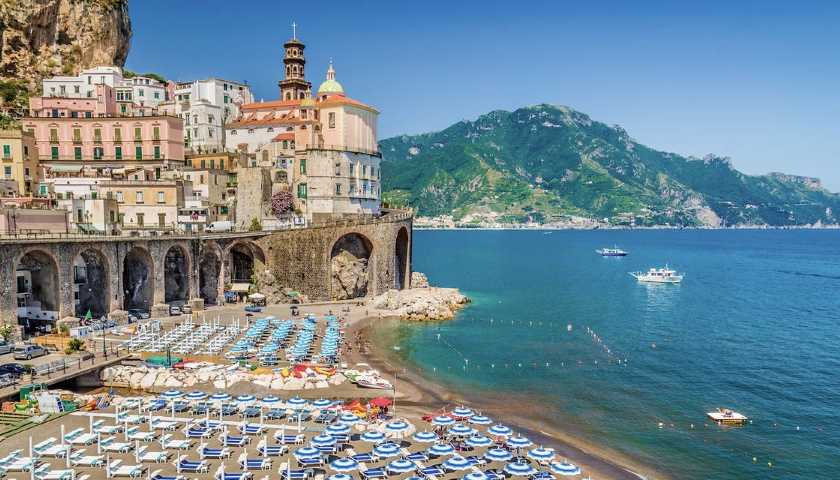
The town of Atrani is located just 700 meters away from the famous Amalfi. Atrani was founded by the ancient Roman aristocracy, and became the wealthy residence of the most powerful families of Amalfi. Unfortunately, the town suffered when Ruggero II, and the Normanni domination began. This was only furthered with the Pisani invasion in 1337, which deprived the entire Amalfi Coast of its independence, and political power. Atrani, today, maintains it's distinct fishermen's town atmosphere.
The main entrance to the town starts from the beach, and from there, the traditional houses climb up the steep mountain valley, intertwined with gardens, and vibrant lemon terraces. Atrani is away from traffic, and confusion (even in summer), because it only opens to its beach, and to the sea. This is probably the secret of its pleasant square which hosts several bars and restaurants. Atrani surely is the place to enjoy a drink or a nice meal in a nice and relaxing atmosphere.
The best restaurants in Atrani
'A Paranza
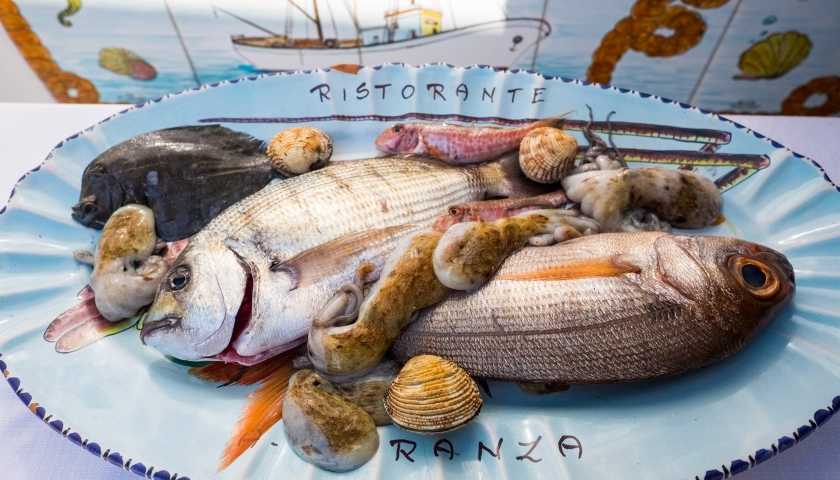
Atrani is Amalfi's smaller and more modest next-door neighbor. One of its attractions is this ultra-authentic trattoria, which offers one of the best traditional seafood meals anywhere along this coast. All the tables are inside, but the thick walls and barrel-vaulted ceilings keep things cool except on the hottest days.
There's no fancy stuff: The Proto brothers, who run the place, know that the best thing to do with a fish if it's fresh is to grill it, so secondi consist mostly of swordfish, or turbot, or pezzogna (spotted bream, a local variety) grilled to perfection. But many people never even get that far, distracted as they are by the abundant spread of antipasti (which might include lightly stewed baby octopus or zucchini flowers filled with sheep's cheese) and by tempting, succulent pasta dishes such as scialatielli 'a paranza (thick, handmade spaghetti with mussels, clams, prawns, and tomatoes).
Service is informal but friendly, and the whole ambience feels grittily local. Open daily July through mid-September; Wednesdays through Mondays end of September through June.
Positano
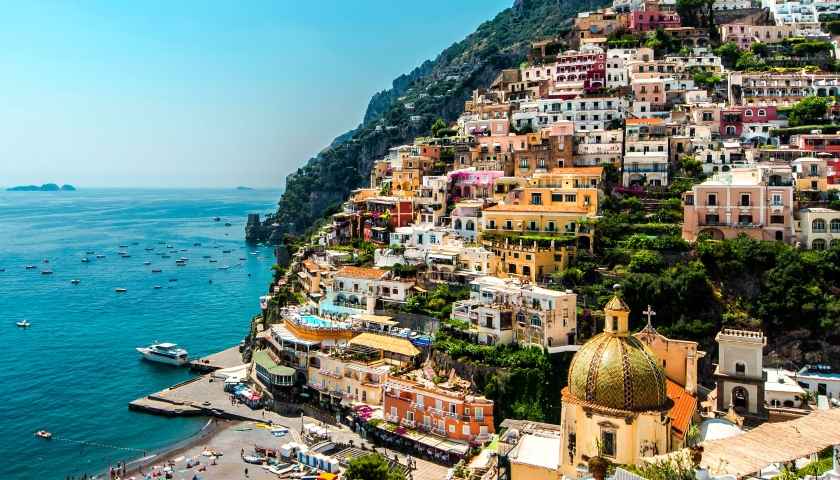
With its beautiful bay and lovely beaches, Spaggia Grande and Fornillo, plus its proximity to the famous island of Capri and the possibly even more beautiful island of Ischia, it’s no wonder Positano is the Amalfi Coast’s number one tourist destination. The gray shingle beach is fine for a quick dip, but most serious sun-worshippers take one of the regular boats to and from a series of smaller coves along the coast.
If you're driving, be warned that the whole town has a painfully slow one-way system that can take the best part of an hour to negotiate: Best advice, if you don't have the benefit of a hotel parking lot, is to leave the car at the first space you find (not an easy task in high season) and walk—or hop on one of the regular buses.
The best hotels in Positano
5-star Il San Pietro di Positano
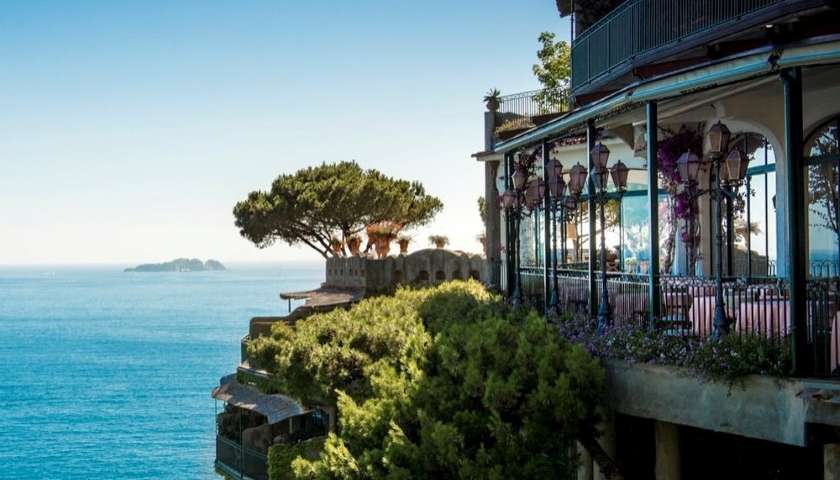
The most striking thing about the San Pietro is its invisibility. No magic rings here: It's just that the hotel seems to merge with the vertiginous cliffs to which it clings. From the sea, this engineering feat is further disguised by the verdant screen of bougainvillea, hibiscus, and grapevines that seem to cascade from terrace to terrace. The 1971 creation of one man, the late Carlo Cinque, the 62-room tumble is now run by his niece, Virginia Attanasio Cinque, and her two sons. About a mile outside Positano on the Amalfi Drive, the hotel is so secluded that it's easy to drive straight past. The only clue that it's there is a discreet sign by an ancient chapel, which turns out to conceal the elevator that whisks guests down to the lobby. A second elevator continues down to the stone sundeck, small private beach, tennis court, and the hotel's new excursion boat. Back "upstairs," there's a new spa and a small semicircular pool lined with Bisazza mosaic tiles, as well as a much-lauded restaurant where Belgian chef Alois Vanlangenaeker works his mojo. Book one of the "special" rooms if you can: They all have features that set them apart, whether it be the largest windows, the most sumptuous decor, or the most expansive bathroom. Book your stay.
5-star Le Sirenuse
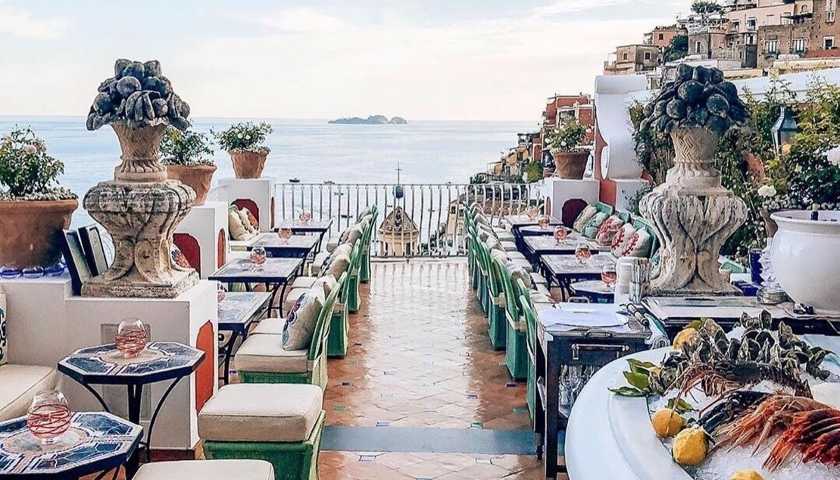
Legendary, sophisticated resort in the center of Positano features beautiful guest rooms with canopied beds and terraces that overlook the famous yellow-and-green duomo of the church of Santa Maria Assunta. The Gae Aulenti–designed Aveda spa (Aulenti renovated Paris's Musée d'Orsay), the Champagne bar with its views down to the sea over the rooftops of the town, and the family's vintage Riva speedboat that you can rent for a spin around the coast only add to the grandeur. Book your stay.
4-star Villa Rosa
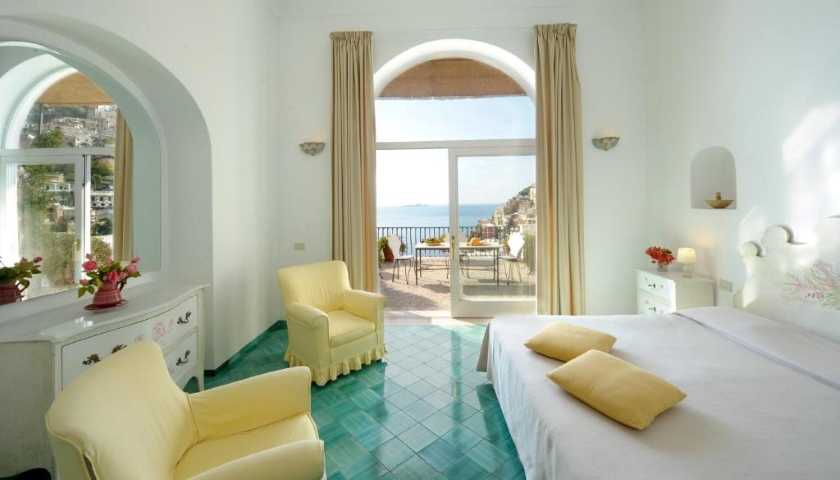
The same views you get from the premium rooms at Le Sirenuse are available for a song—and from your own bougainvillea-decked terrace—at this superfriendly 20-room hotel in a classic Mediterranean village house. The spotless, air-conditioned rooms are sparsely but comfortably furnished and have whitewashed walls and terrazzo-tiled floors. In addition, each room is equipped with a refrigerator, TV, and phone. There's no restaurant, but cappuccino and pastries are delivered to your terrace for breakfast, and lots of other eating options are just a short stroll away. The rooms on the top two floors have the best views. Book your stay.
The best restaurants in Positano
Da Vincenzo

This historic family restaurant has long been one of the most reliable places in Positano for a good-value meal. Its location, about halfway up the near-vertical stack of houses on the west side of town, makes for a thigh-testing climb from the beach, but it's well worth the effort, as Da Vincenzo is much better than any of its waterside rivals. This is a serious family restaurant with affable waiters who know a thing or two about wine, and a real dedication to seasonal local cuisine.
Though the secondi are good, most habitués go for a selection of antipasti—don't miss the skewered grilled octopus accompanied by crispy, deep-fried artichokes—followed by a pasta dish such as the delicious, herby linguine with anchovies and wild fennel, perhaps finishing up with a homemade dessert made by Mamma Marcella. The outside tables are strung along the road, but close encounters with buses, scooters, and strolling locals are all part of the Da Vincenzo buzz. Open Wednesdays through Mondays 1 to 3 pm and 7 pm to midnight, November through April.
Next 2
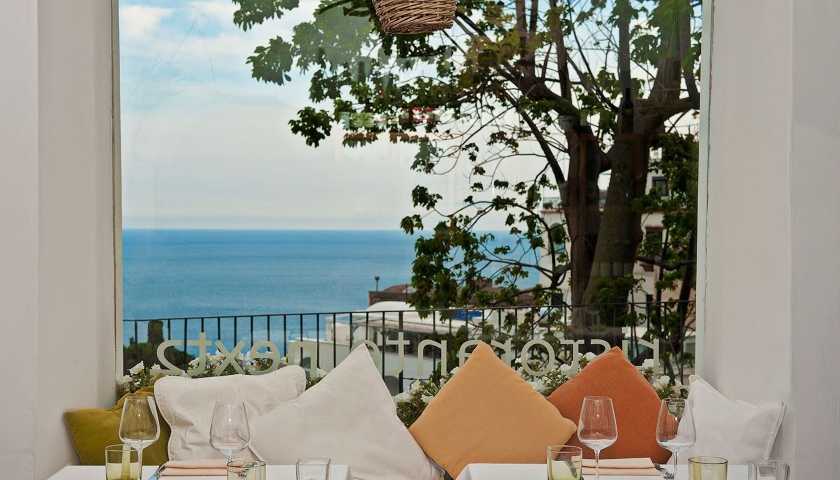
Don't be fooled by the ambient music and the Miami-minimalist design aesthetic. Beneath its stylish veneer, this cool new bar-restaurant a few doors up from Da Vincenzo has solid local credentials and takes its food and wine very seriously. Next 2 is also surprisingly good value, at least for Positano. Some dishes, like the pumpkin soup with rosemary oil and a sprinkling of shrimp, fall into the creative category but others—the sartù di riso or slow-baked beef braciola in tomato sauce—are classic Neapolitan dishes, sharpened and refined rather than revisited.
An outside patio set back from the road makes for a relaxed alfresco meal. In high season, the patio also acts as a venue for occasional jazz concerts. The wine list is a pleasure to read. It's not a huge selection but one that's clearly been drawn up by someone who knows their Italian producers from Alto Adige down to Campania. Open daily 6 pm to 2 am, April through the first week of November.
Donna Rosa
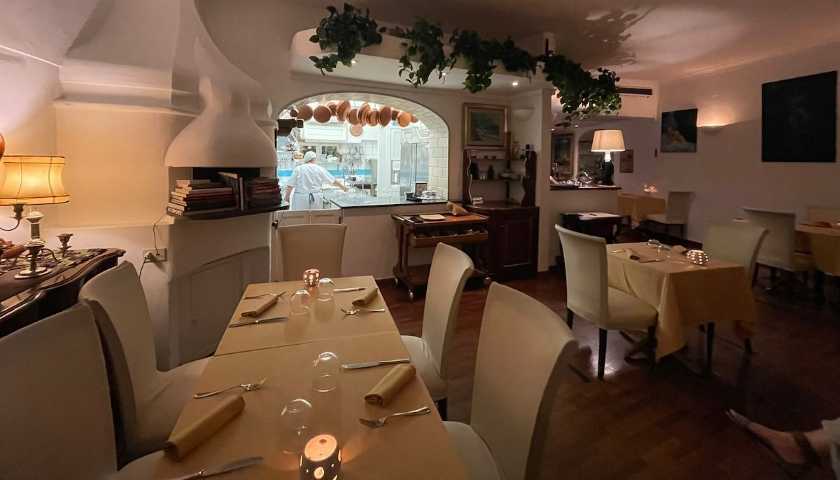
High above Positano is a tiny village called Montepertuso. Once upon a time, the only way to get up here was on foot or by donkey. These days there's a road which brings one up in around 20 minutes from the Amalfi Drive junction. Positanesi and tuned-in visitors brave the curves of an evening to bask in the cool mountain air and to eat at Donna Rosa.
The decor is perhaps more bijou-elegant than one would expect in such a rural backwater but the cooking is of the delicious, down-home variety, with primi such as Black & White ai frutti di mare (black-and-white strips of homemade pasta served with seafood) and terrific desserts (make room for the hot chocolate soufflé). The wine list is another bonus. It's a really knowledgeable selection, particularly strong on whites from the Campania region.
Opening times vary according to the time of year, but the general rule is that in August they're open daily for dinner, in July and September they add lunch from Wednesday to Sunday, and in the low season they close on Tuesdays. Oh, and they shut down between November 5 and Easter. Simple, huh?
Ravello
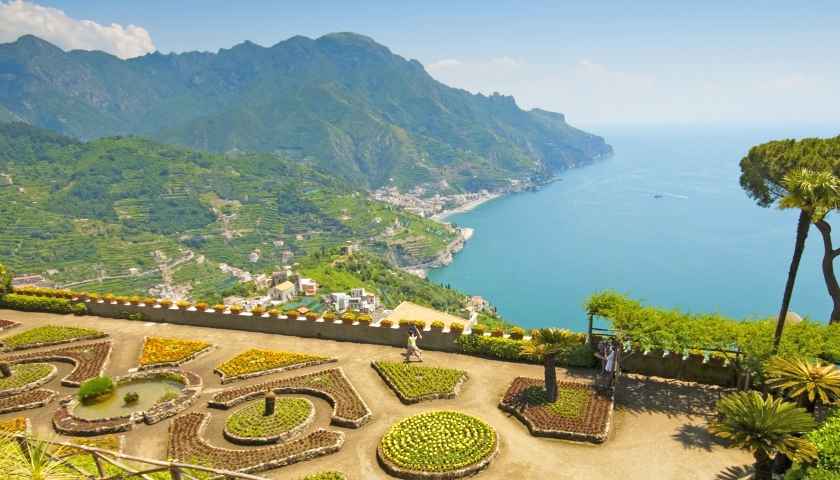
Perched high above the hustle and bustle of the seaside, peaceful Ravello has always been the gentleman scholar of the Amalfi Coast. In the 12th and 13th centuries, the town housed a thriving mercantile community, but with the end of Amalfi's maritime supremacy the town went into rapid decline, turning it into a crumbling, atmospheric medieval Pompeii.
Rediscovered by 19th-century Grand Tourists, Ravello was adopted by artists, musicians, and writers. Wagner turned the romantic gardens of Villa Rufolo into the magic garden of Klingsor, setting for Act II of his opera Parsifal, and D. H. Lawrence wrote parts of Lady Chatterley's Lover here. Later, Gore Vidal adopted Ravello as his home.
Founded in the 11th century, the Duomo contains two exquisite 13th-century pulpits, one with delightful mosaics of Jonah and the Whale. Nearby Villa Rufolo is a historical pastiche, artfully assembled from the surviving fragments of the original medieval structure by a Scottish nobleman who bought the place in 1851. It has magnificent views over the Bay of Maiori and Gulf of Salerno and heavenly gardens that host classical music concerts during the Festival di Villa Rufolo ( June through September).
The other must-see garden in Ravello is Villa Cimbrone, a 15-minute walk through the lanes of the old town, with its rose-flanked walks and Belvedere view, lined with classical statues. The main villa (now a luxury hotel) was the love nest of Greta Garbo and conductor Leopold Stokowski in the 1930s.
Insider Tip: The Ravello Festival, one of Italy's oldest festivals, takes place each year from July to September. This musical extravaganza features a range of concerts plus dance performances and art exhibits held in churches, gardens, and piazzas around Ravello.
The best hotels in Ravello
5-star Hotel Caruso
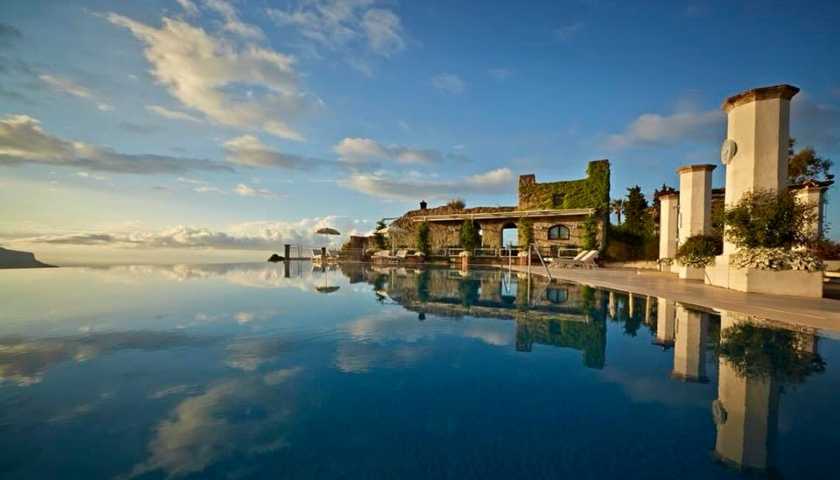
The legendary Hotel Caruso (its fans have included Greta Garbo, Jackie Kennedy, Humphrey Bogart, and Virginia Woolf) started in 1893 as Pantaleone Caruso's small pensione. Now this luxury seasonal hotel has 47 rooms, most with balconies and 15 with private gardens. There's a heated infinity pool worthy of the name, a gym and a Wellness Centre offering massages and body treatments.
The hotel's two restaurants make the best of the views; there's also a poolside snack bar, and a piano bar with 18th-century frescoes. A complimentary shuttle connects with Positano and Amalfi; morning boat excursions are also gratis. But "gratis" is a relative term here: 22 of the rooms have per-night price tags of a thousand euros or more. Book your stay.
5-star Palazzo Avino
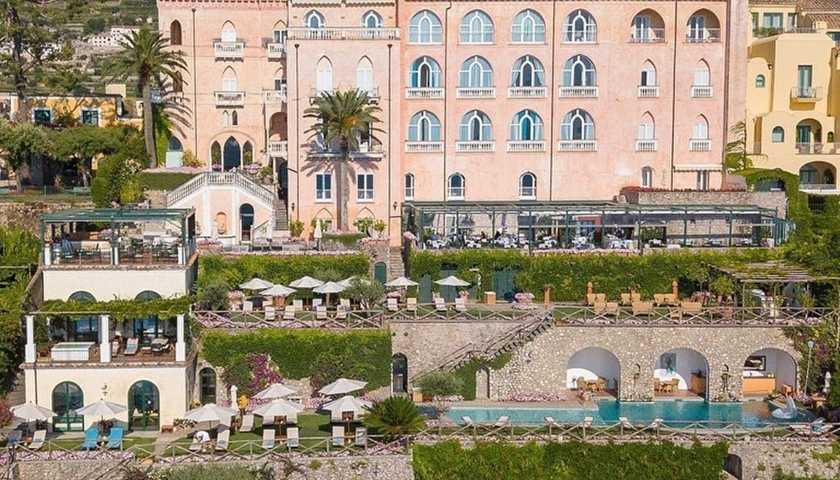
The ruined Renaissance palace that houses this 43-room hotel was given a complete overhaul in 1997, resulting in an opulent pink bonbon that has everything going for it except antique atmosphere. Unlike the revamped Hotel Caruso, Palazzo Avino makes no attempt to conceal the fact that it is a hotel rather than a princely residence. There are twice as many staff members as rooms and all the amenities to boot (a rooftop sundeck with two plunge pools, hot tubs, satellite TV, Frette linens, Bulgari bath products, and a Moroccan-style spa), however, so no one's complaining.
The rooms are lavishly done in handmade Vietri tiles, with precious rugs, antiques of assorted periods, and heavy swag curtains. Unfortunately, only ten of them—all of them suites—have balconies or terraces. Still, as long as you don't get stuck with the one entirely viewless internal room, you'll likely be happy (you can always head to the roof terrace or the swimming pool surrounded by gardens to get your fresh-air fix).
The gym has a panoramic view, too: the equipment is set high on the mountainside under gazebo tents. The main restaurant, Rossellinis, is among the best in Italy, but there's also a more casual place and a café for your less extravagantly gastronomic moods. From summer 2009, a private villa called Clubhouse by the Sea has opened for the exclusive use of guests. The villa has a saltwater pool, gardens with two cabanas, changing rooms, two "relaxation living rooms", and a small restaurant serving pizzas and seafood, and a bar. Clubhouse by the Sea is a bracing 40-minute walk downhill to the coast from Ravello, but there's also a free private shuttle from the hotel for those who don't want to exert themselves too much. Book your stay.
3-star Hotel Villa San Michele (Castiglione di Ravello)
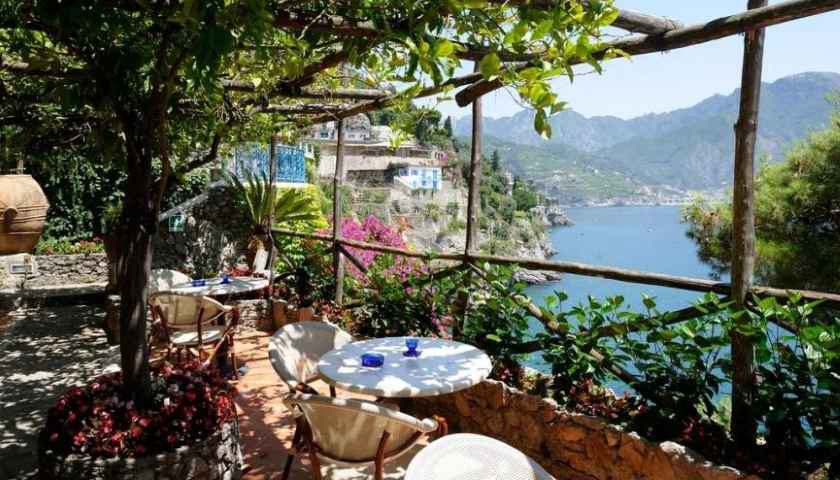
Nestled among stone-walled terraces and gardens full of lemon trees and bougainvillea, this simple, friendly 12-room hotel sits on a cliff between Amalfi and Ravello. A winding staircase carved into the cliffside takes you down to the rocky beach (really more of a swimming platform), from which you can arrange to be whisked away by boat. Almost all of the rooms have balconies for drinking in views of the Gulf of Salerno, and for alfresco breakfasts.
Rates include a meal plan, which is great if you're lazy and/or carless, but the quirky, family-run restaurant is also a treat in its own right. The simple guest rooms have traditional tiled floors, paisley drapes, and bright-blue woodwork. Air-conditioning, satellite TV, and direct-dial phones are also standard. There's no pool.
Praiano
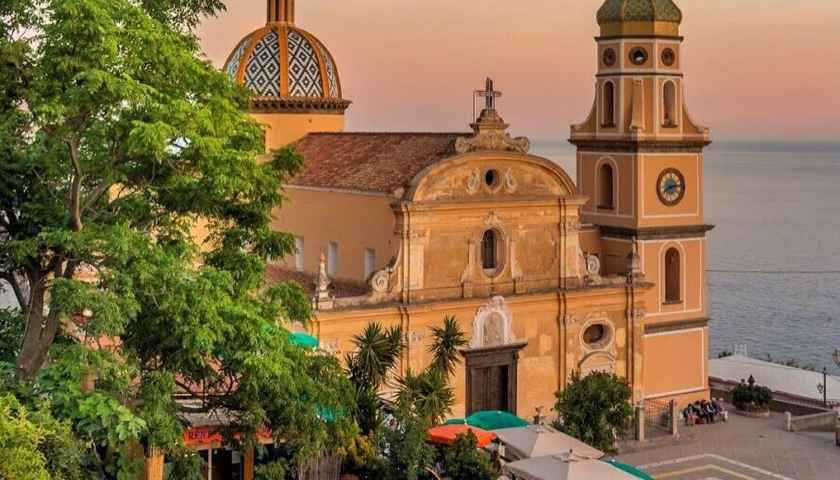
A tiny seaside gem which hides between the busier Positano and Amalfi, Praiano has managed to cling on to its character of fishing village. Praiano is one of the most genuine corners of the Amalfi Coast, away from the most touristy areas and rich with history, culture, views and comforts. Life is slower than in the larger towns and thus the cafes and bars are friendly, and the locals have time to sit in the piazza in front of the Church of St Luke, enjoy the views over the sea and discuss the day’s happenings.
Inside, the church houses a precious silver icon of Saint Luke. The glorious Marina di Praia beach sits at the end of a wild valley of steep and deeply eroded cliffs with deep, blue water at their base, perfect for scuba diving. It is guarded by the ancient Torre a Mare, once necessary to fend off marauding pirates; these days the piracy is probably more related to sunbathing space.
The best hotels in Praiano
5-star Casa Angelina Lifestyle Hotel
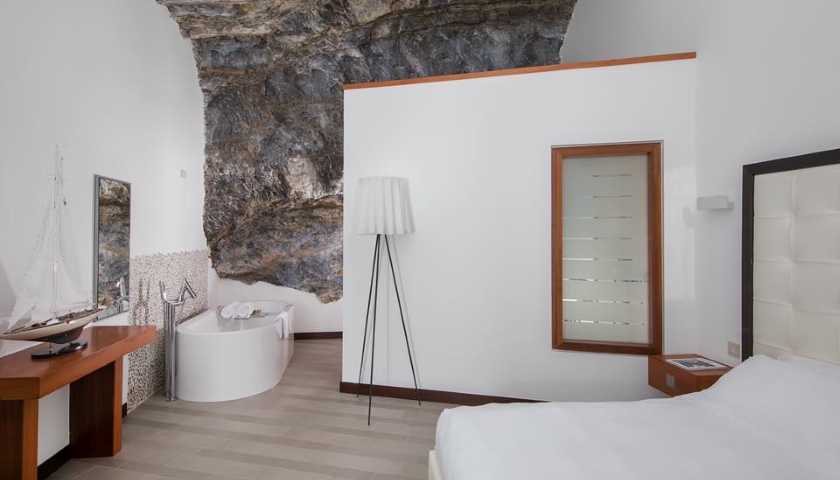
The Amalfi Coast's first design hotel is no empty style exercise. This boxy, postwar structure that sits in glorious seclusion above a private beach a few miles east of Positano used to harbor an undistinguished package hotel, but it was bought up by hotelier David Stein's Franklyn Hotels and Resorts and reopened in June 2005 as a cool seaside refuge. The all-white decor in the 45 rooms and suites (most with terraces) will feel antiseptic to some, but it's softened by fresh flowers and warm teak flooring, while playful glass sculptures jazz up the lounge and cigar room.
The panoramic rooftop restaurant gives the local tradition a light, creative twist in dishes such as citrus-fruit risotto with red king prawns, or braised gilthead bream with wild fennel and star anise. The lift to the beach still leaves 190 steps to climb down and up; but for those who can't face the legwork, there are two pools, one inside the fitness area and the other outside on a decked terrace. There's no spa as such, but a masseuse is on hand between 11 am and 7 pm. Book your stay.
3-star Ca' P'a Casa Privata
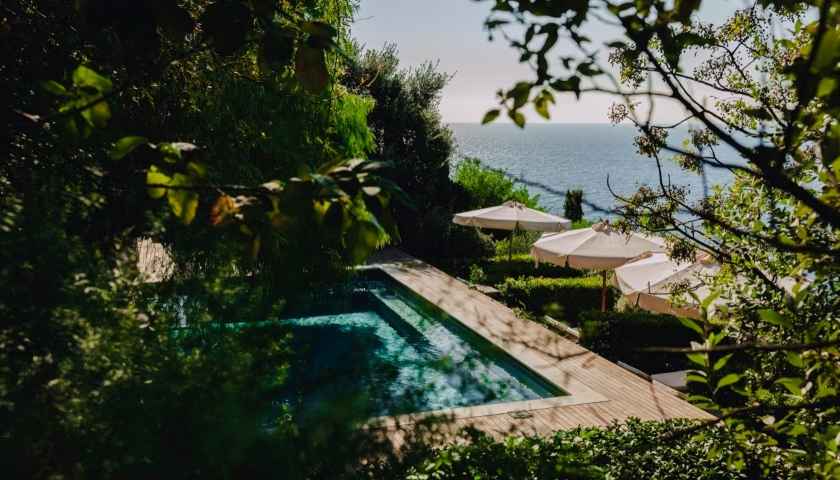
Once a fisherman's home, Ca' P'a, the restored dream house of a family of architects, doubles as a seven-room inn saturated with Mediterranean charm and contemporary good taste. Every bedroom has a 14-foot domed ceiling and a glorious sea view, although there's no AC. The simple accommodations are softened with natural colors and lots of pillows, and the two suites have four-poster beds with mosquito netting. There's a small seawater pool, and terraced gardens slope down to the rocky coast. When to go: April through June, September and October. Which room to book: The new private garden suite two steps away from the main villa which has its own terrace leading onto the 5,000 square meters garden.
Cetara
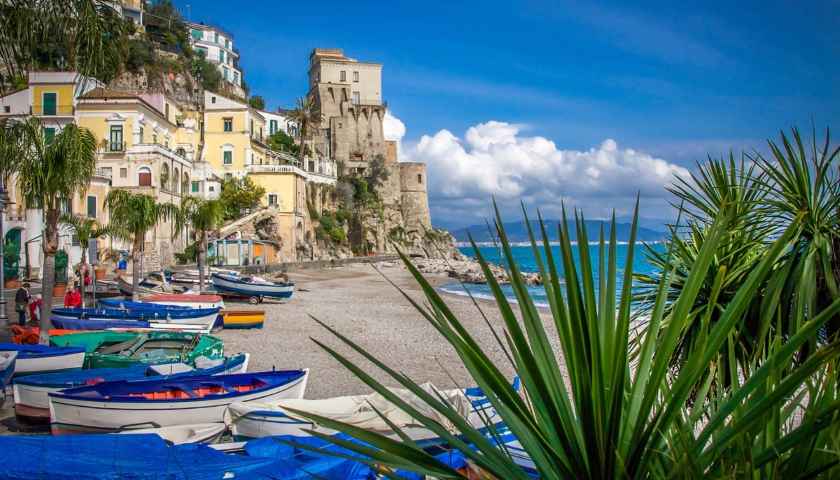
Cetara is a fishing port in the true sense of the word: Rather than have a few gaily painted wooden boats pulled up onto the beach, this lively town east of Amalfi has a fleet of state-of-the-art trawlers that venture as far as the coast of Libya and use tracker planes to help spot the shoals.
The best restaurants in Cetara
Acqua Pazza
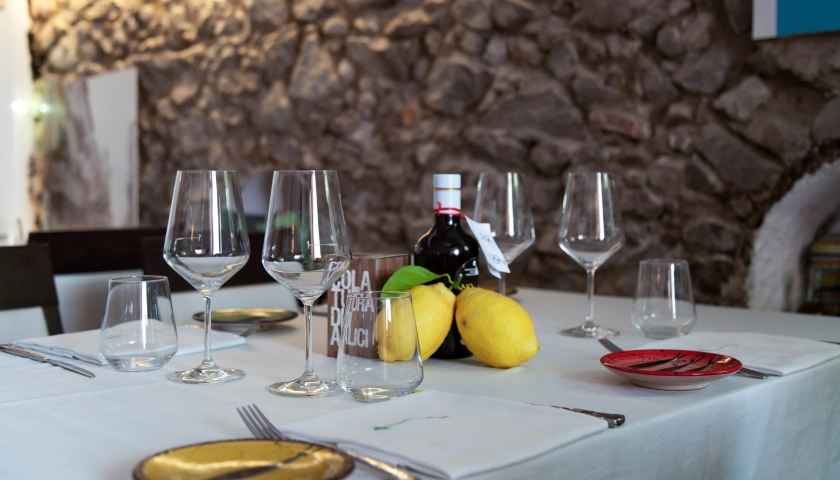
A great seafood restaurant that is as good as—and much better value than—anything you are likely to find between Amalfi and Positano. At Acqua Pazza (the name refers to a local technique of cooking fish in a court bouillon), a laid-back den down by the port where every meal becomes a sort of salon presided over by genial owner-chef Gennaro Marciante. Don't miss the delicate seafood antipasti or the linguine with colatura d'alici, a local anchovy sauce that is the direct descendant of the garum of the Ancient Romans. But don't turn up too early for dinner: Things don't really get underway here until after 9 pm. Open daily June through August; closed Mondays September through May; closed December through January.
Sant'Agata sui due Golfi (best restaurant and hotel)
Don Alfonso 1890
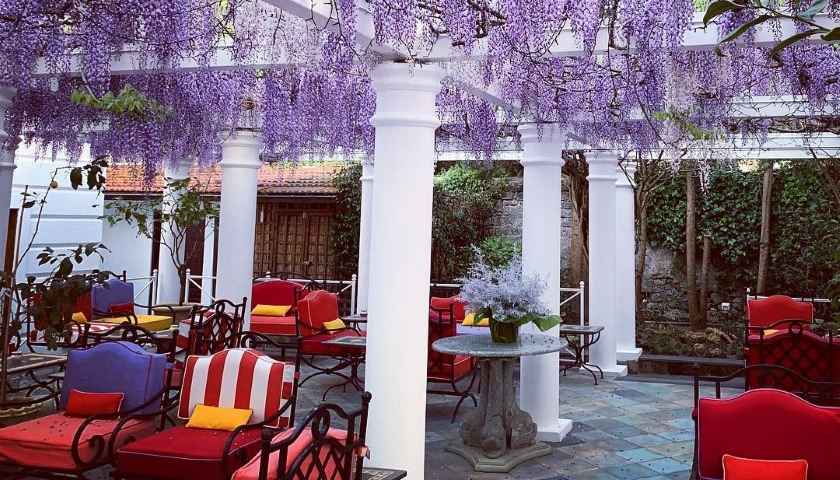
The little town of Sant'Agata is a rather modest place, but it plays host to what is generally (and rightly) considered to be the best table south of Rome, presided over by the indefatigable Alfonso Iaccarino—grandson of the original Alfonso, who was born in 1890. (They like to keep things in the family here: Alfonso's sons Ernesto and Mario work as assistant chef and dining-room host, respectively). All the fruit, vegetables, and herbs come from the family's farm, Le Peracciole, including Nocellara, Moraiola, and Frantoio olives, which they handpick and cold-press the same day for the exquisite fruity, spicy oils integral to Iaccarino's cuisine.
The food thinks local but acts global, updating age-old Campanian recipes in dishes such as annecchia (halfway between veal and beef) with guanciale bacon, fior di latte cheese, and potato-and-sage foam. The kitchen can also find virtue in simplicity, with a plate of ravioli filled with caciotto cheese and marjoram, topped with a sauce of Vesuvian tomatoes and basil.
There's also the option of staying overnight in one of the nine rather grand rooms. And breakfast comes from Don Alfonso's kitchen. Open Tuesday evening and all day Wednesday through Sunday, June through September; all day Wednesday through Sunday, October to mid-November, April, and May; closed mid-November through March.
Amalfi Coast Trip Plans
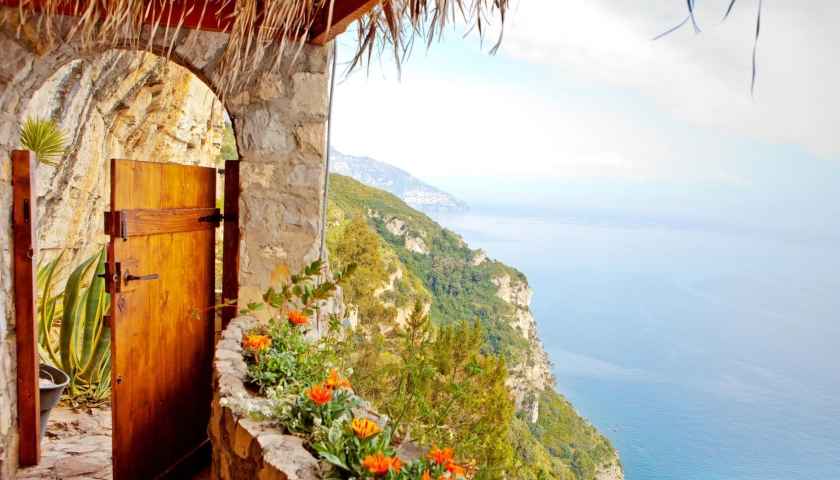
Planning a trip to Italy's Amalfi Coast? For inspiration browse these vacation ideas. Nancy Aiello Tours can create a private journey to your tastes, built around the sites you want to visit and the activities you want to do. To get started creating your one-of-a-kind private Amalfi Coast journey fill out our quick Trip Inquiry form. One of our dedicated Travel Specialists will be in touch with a customized itinerary for you.
Stay up to date with travel tips & local insights and follow our adventures in Italy on Facebook and Instagram – we share travel inspiration, news, and insights that will brighten your day and whet your appetite for that next travel adventure!
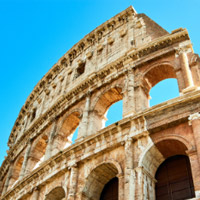 Rome & Vatican
Rome & Vatican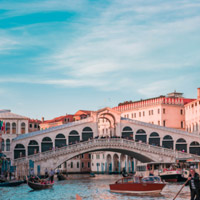 Venice
Venice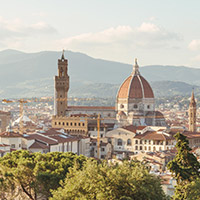 Florence & Tuscany
Florence & Tuscany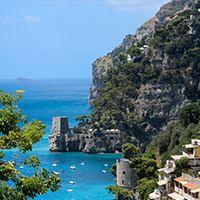 Napoli & Amalfi Coast
Napoli & Amalfi Coast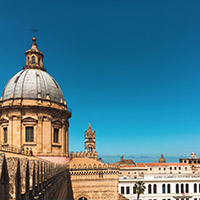 Sicily
Sicily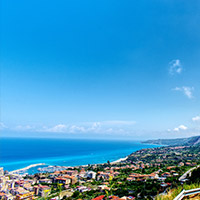 Calabria
Calabria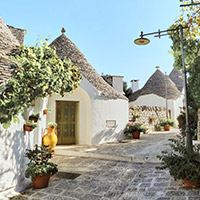 Matera & Puglia
Matera & Puglia